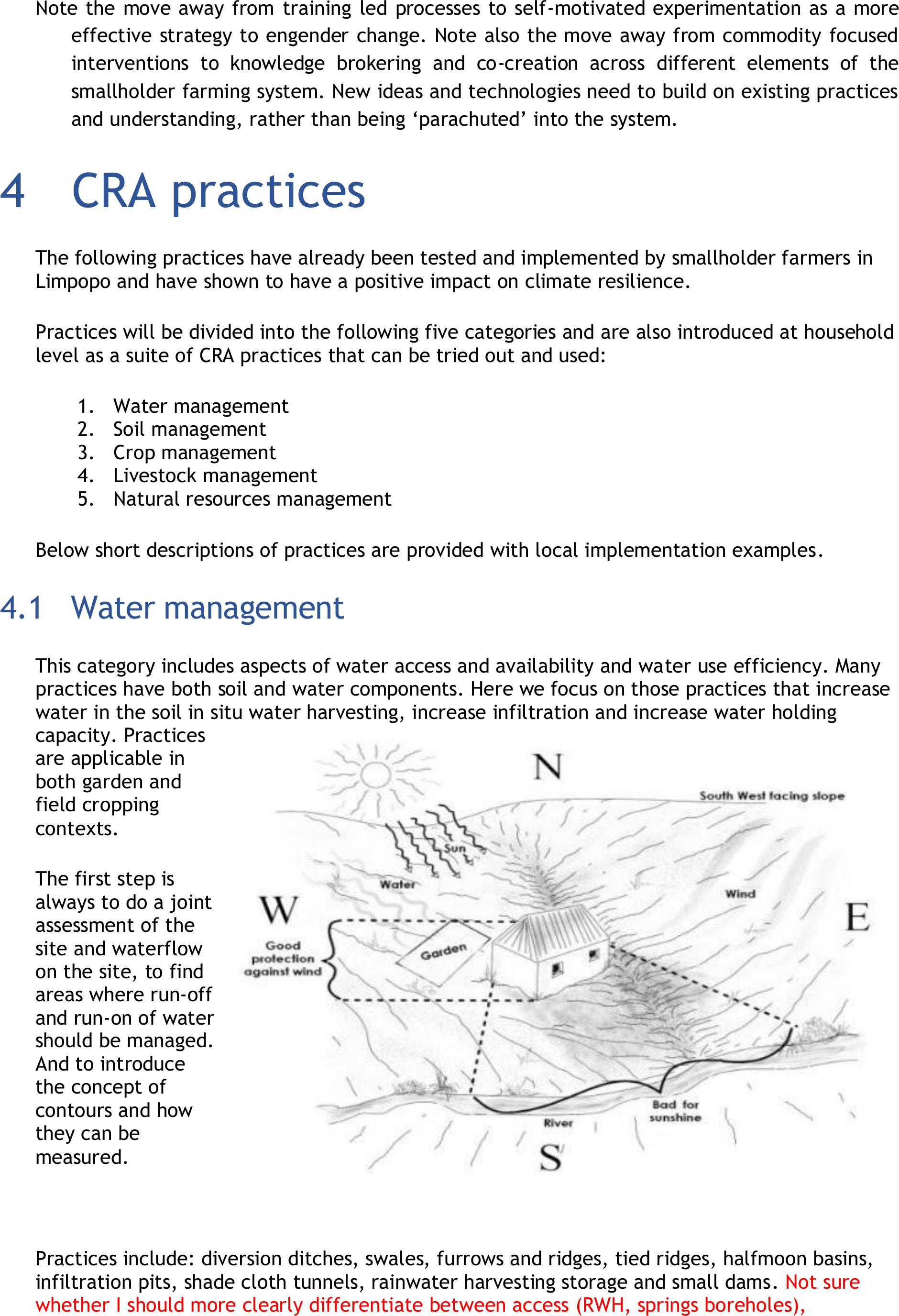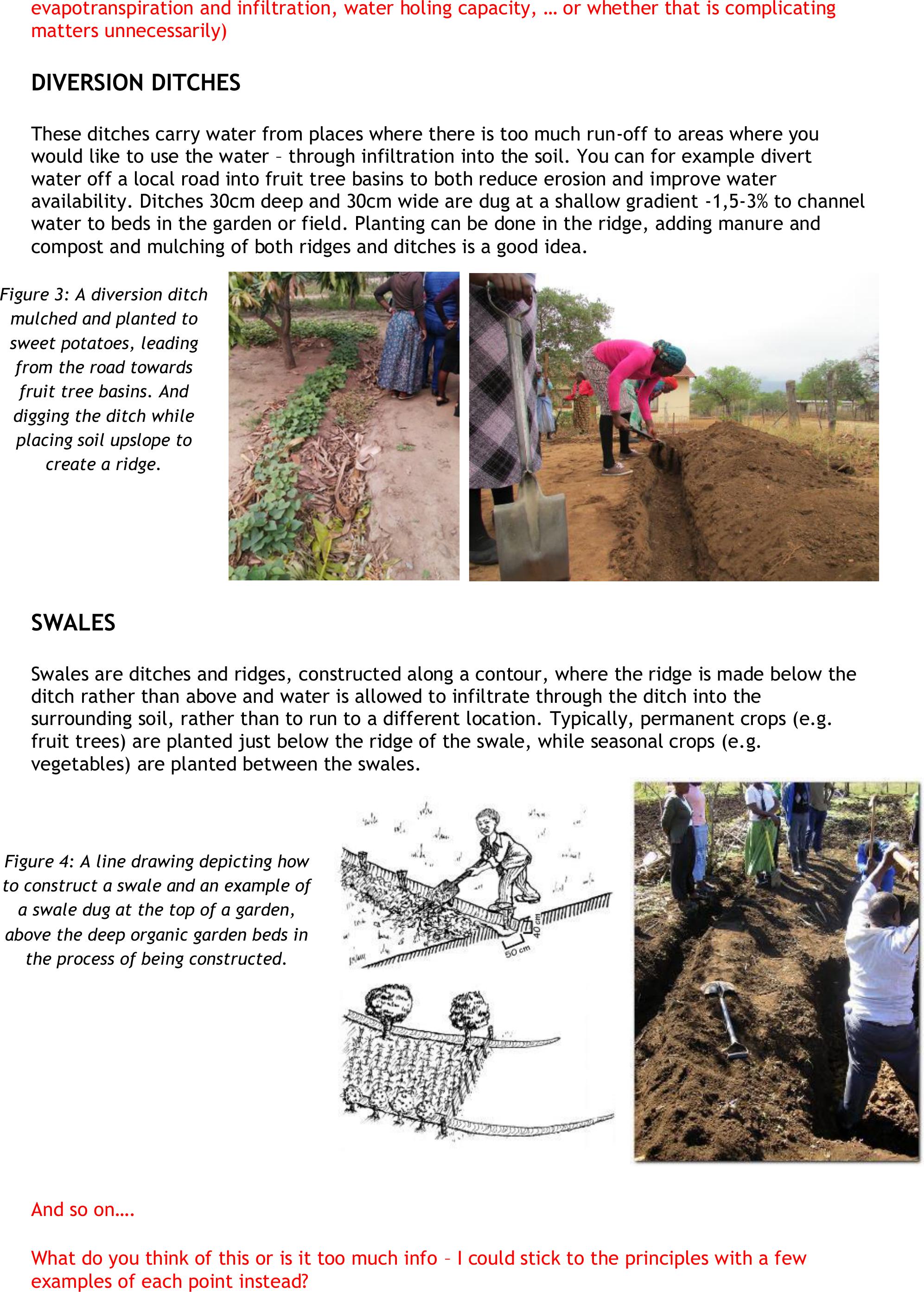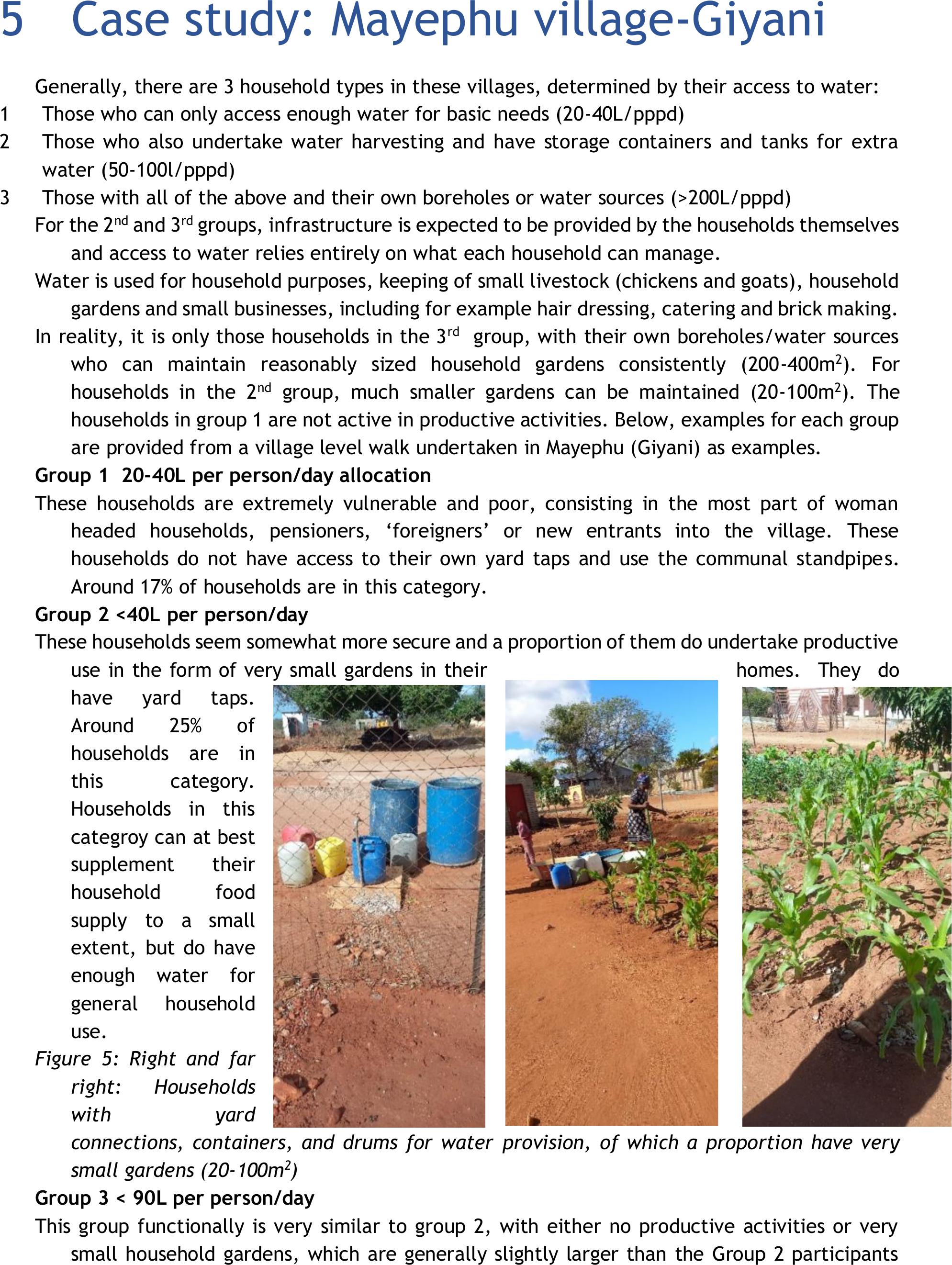
Homestead food production in a
changing climate
1 Background
Smallholder farmers in Limpopo live in communal tenure villages with access to homestead
gardens, including small livestock, field cropping (either dryland or irrigated) and communal
grazing for livestock.
Figure 1: The smallholder farming system
Access to water (both quantity and quality) limits food production potential. Water for irrigation is
not provided at household level and often households struggle just to get access towater for
basic needs. The Giyani region has experienced significant impacts from climate change,
including more frequent and severe droughts, erratic rainfall patterns, andincreased water
scarcity. These changes have adverselyaffected agriculture,livestock farming, and water
availability fordomestic use, posing substantialchallenges tothe livelihoods and well-being of
local communities.
The GLSCRP (GiyaniLocal Scale Climate Resilience Programme)promotes innovative climate
adaptation solutions in Giyani, including rainwater harvesting, small-scaleirrigation, wastewater
treatmentand recycling, and climate-smartagriculture. The program aims to demonstrate the
feasibility andeffectiveness of these solutions, encouraging wider adoption throughout the
region.
This document provides principles andpractices for improved climate resilience in intensive
homestead food production.
Smallholder
farming
system
Field cropping of staples
on small patches of
available land (0,1-2,5ha)
Extensive grazing
of livestockon
stover and veld
Intensive homestead
food production;
vegetables, fruit, small
livestock (100-250m2(
Feed
Biomass
mulch
Fodder
manure
stover
Manure
mulch

2 Introduction
Climate Resilient Agriculture can be defined as “agriculture that reduces poverty and hunger in
the face of climate change, improving the resources it depends on for future generations”
(Kruger, et al., 2021)
Climate resilient agriculture (CRA)aims to sustainabilityincrease agricultural productivity and
incomes while adapting our farming practices to the changing climate while making sure that
ourfarming is friendly to nature. It is about making changes to how we farm that will improve
both our ability and the ability of the environment to cope with these changes.
The emphasis is at farm/household level. CRA aims to improve aspects of crop production,
livestock and pasture management, natural resource management, as well as soil and water
management as shown in the figure below.
Figure 2: Household level implementation of CRA integrates acrosssectors. Adapted from (Arslan, 2014).
There are a range of farming practices that can be useful. The idea is that we try out thepractices
that are appropriate for us, where we live and compare them with what we are doing already,
to observe the differences and tomake decisions from there about changing our farming
systems. Combining a number of different practices will increase their effect.
The challenge is thus to work with a combination ofaspects; soil fertility, soil erosion control,
water management, cropping, fruit tree production, livestock integration and natural
resources management, to create a more productive and resilient, intensive homestead food
production system, working within the confines of the local situation and resources.
Crops Livestock
Soil health
and
fertility
Water
Natural
resources/
landscape
SYNERG
IES
Soil
and water
conservation

3 Principles
Climate change adaptation (CCA) for smallholder farmers requires the transition to agricultural
production systems that are more productive, use inputs more efficiently, have less
variability and greater stability in their outputs, and are more resilient to risks, shocks and
long-term climate variability. This requires a major shift in the way land, water, soil nutrients
and genetic resources are managed.
The 10 elements ofAgroecology, as outlined by the FAO are a very usefulframework….
Diversity;synergies; efficiency; resilience; recycling; co-creation and sharing of knowledge
(describing common characteristics of agroecological systems,foundational practices and
innovation approaches)
Human and social values; culture and food traditions (context features)
Responsible governance; circular and solidarity economy (enabling environment)
Not sure whether should include the agroecology principles here? Or just stick to the five finger
and synergies mentioned above –should I morecoherently include five fingers in this
document?
The following guidelines are important
1.Start with what people know and work from there
2.Develop adaptive strategies and prioritized practices at a local context (Come with ideas not ‘solutions’)
3.Compare new ideas to present practise and analyse advantages and disadvantages
4.Synergize across different activities (think cyclical not linear)
5.Use available water as efficiently as possible
6.Minimize external inputs
7.Pay attention to soil conservation and soil fertility
8.Focus on soil health and natural soil building techniques
9.Diversify
10.Take care of the environment
11.Work together learn together and plan together
Include a succinct paragraphs for each principle –they presently feel a bit unwieldy –will try and
consolidate more)

Notethe move away from training led processes to self-motivated experimentation as a more
effectivestrategy to engender change. Note also themove awayfrom commodity focused
interventions to knowledge brokering and co-creation across different elementsof the
smallholder farming system. New ideas and technologiesneed to build on existing practices
and understanding, rather than being ‘parachuted’ into the system.
4 CRA practices
The following practices have already been tested and implemented by smallholderfarmers in
Limpopo and have shown to have a positive impact on climate resilience.
Practices will be divided into the following five categories and are also introduced at household
level as a suite of CRA practices that can be tried out and used:
1.Water management
2.Soil management
3.Crop management
4.Livestock management
5.Natural resources management
Below short descriptions of practices are provided with local implementation examples.
4.1 Water management
This category includes aspects of water access and availability and water use efficiency. Many
practices have both soil and water components. Here we focus onthose practices that increase
water in the soil in situ water harvesting, increase infiltration and increase water holding
capacity. Practices
are applicable in
both garden and
field cropping
contexts.
The first step is
always to do a joint
assessment of the
site and waterflow
on the site, to find
areas where run-off
and run-on of water
should be managed.
And to introduce
the concept of
contours and how
they can be
measured.
Practices include: diversion ditches, swales, furrows and ridges, tied ridges, halfmoon basins,
infiltration pits, shade cloth tunnels, rainwater harvesting storage and small dams. Not sure
whether I should more clearly differentiate between access (RWH, springs boreholes),

evapotranspiration and infiltration, water holing capacity, … or whether that is complicating
matters unnecessarily)
DIVERSION DITCHES
These ditches carry water from places where there is too much run-off to areas where you
would like to use the water – through infiltration into the soil. You can for example divert
water off a local road into fruit tree basins to both reduce erosion and improve water
availability. Ditches 30cm deep and 30cm wide are dug at a shallow gradient -1,5-3% to channel
water to beds in the garden orfield. Planting can be done in the ridge, adding manure and
compost and mulching of both ridges and ditches is a good idea.
Figure 3: A diversion ditch
mulched and planted to
sweet potatoes, leading
from the road towards
fruit tree basins. And
digging the ditch while
placing soil upslope to
create a ridge.
SWALES
Swales are ditches and ridges, constructed along a contour, where the ridge is made below the
ditch rather than above and water is allowed to infiltrate through the ditch into the
surrounding soil, rather than to run to a different location. Typically, permanent crops (e.g.
fruit trees) are planted just below the ridge of the swale, while seasonal crops (e.g.
vegetables) are planted between the swales.
Figure 4: A line drawing depicting how
to construct a swale and an example of
a swale dug at the top of a garden,
above the deep organic garden beds in
the process of being constructed.
And so on….
What do you think of this or is it too much info – I could stick to the principles with a few
examples of each point instead?

5 Case study: Mayephu village-Giyani
Generally, there are 3 household types in these villages, determined by their access to water:
1Those who can only access enough water for basic needs (20-40L/pppd)
2Those whoalso undertake water harvesting and havestoragecontainers and tanks for extra
water (50-100l/pppd)
3Those with all of the above and their own boreholes or water sources (>200L/pppd)
For the 2ndand 3rdgroups, infrastructure is expected to be provided by thehouseholds themselves
and access to water relies entirely on what each household can manage.
Water is used for household purposes, keeping of small livestock (chickens and goats), household
gardens and small businesses, including for example hair dressing, catering and brick making.
In reality, it is only thosehouseholds in the3rdgroup, with their own boreholes/water sources
who can maintain reasonably sized household gardens consistently (200-400m2). For
households in the 2ndgroup, much smaller gardens can be maintained (20-100m2). The
households in group 1 are not active in productive activities. Below, examples for each group
are provided from a village level walk undertaken in Mayephu (Giyani) as examples.
Group 1 20-40L per person/day allocation
These households are extremely vulnerable and poor, consisting in the most part of woman
headed households, pensioners, ‘foreigners’ or new entrantsinto the village. These
households do not have access to their ownyard taps and use the communal standpipes.
Around 17% of households are in this category.
Group 2 <40L per person/day
These households seem somewhat more secure and a proportionofthem doundertake productive
use in the form of very small gardens in their homes. They do
have yard taps.
Around 25% of
households are in
this category.
Households in this
categroy can at best
supplement their
household food
supply to asmall
extent, butdo have
enough water for
general household
use.
Figure 5: Right and far
right: Households
with yard
connections, containers, and drums for water provision, of which a proportion have very
small gardens (20-100m2)
Group 3 < 90L per person/day
This group functionally is very similar to group 2, with either no productive activities or very
small household gardens, which are generally slightly larger than the Group 2 participants

averaging around 200m2. Around 24% of the community fallwithin this category. Afew of the
participants do have small livestock in the form of traditional poultry.
Group 4 >200l per person/day
Households in this
category have
small livestock
(chickens,
goats) as well as
well
established,
thriving
household
gardens. In
addition,
participants in
this group have
small, but
diverse fruit
orchards.
Figure 6: Right to
far right.
Example of a household borehole
with storagetanks, a goat enclosure and a chicken house at different households. Insert is
of a traditional laying box, with eggs.
Figure 7: Above left to right:Household gardenswith a wide range of crops (mustard, tomatoes,
cabbage, onions, marrows, spinach etc) andexamples of small orchards (citrus, bananas,
paw-paws, macadamia nuts, sugar cane avocados, mangoes and litchis)
Irrigation practices in the gardens consist mainly of hosepipes and buckets irrigating into
adaptations of short furrow irrigation, or drip irrigation. All householders interviewed are
veryaware of salinity issues in their waterand management practices and havealready

adapted their crop varieties, watering regimes and soilmanagement to accommodate for
this. The use of ridges and furrows is further considered a good practise in this regard. There
is however potential for mulching, intercropping and methods of incorporating soil organic
matter, to further assist.
There are some beautiful
examples also of
integration of
traditional crops such
as Cleome, pumpkins
and gourds and Luffa
forexample into the
gardening systems.
Figure 8: Left to right;
traditional crops-
pumpkins/gourds,
cleome and Luffa.
There is a clear
progression from no
productive activities
to household
gardens, to further
inclusion of small livestock to inclusion also of fruit trees, depending on the amount of water
consistently available to households. It indicates thatthese communities are intrinsically
aware of water demand for productive activities and would undertake a much larger range
of activities if water wasn’tlimiting. In addition, dryland field cropping, which was a common
practise in the past, has become unviable underthe present climatic conditions. It has
become too dry and hot to produce dryland maize and is now risky even for traditional crops
such as sorghum, cowpeas, jugo beans, ground nuts and pumpkins. For the latter people will
still take a chance and plant these crops when reasonable amounts of early summer rainfall
is in evidence.
6 References